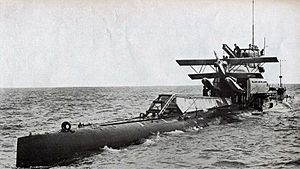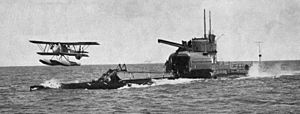HMS M2 facts for kids
class="infobox " style="float: right; clear: right; width: 315px; border-spacing: 2px; text-align: left; font-size: 90%;"
| colspan="2" style="text-align: center; font-size: 90%; line-height: 1.5em;" | 
|}
HMS M2 was a special type of Royal Navy submarine built in 1919. It was first designed as a 'monitor' submarine, meaning it carried a very large gun. Later, in 1927, it was changed into a unique submarine aircraft carrier, carrying its own small airplane! Sadly, HMS M2 sank during an exercise in Lyme Bay, Dorset, Britain, on January 26, 1932. It was one of only three M-class submarines ever finished.
Contents
| History | |
|---|---|
| Name | HMS M2 |
| Builder | Vickers |
| Laid down | 1916 |
| Launched | 1919 |
| Fate | Sank during exercise, 26 January 1932 |
| General characteristics | |
| Class and type | M-class submarine |
| Displacement |
|
| Length | 295 ft 9 in (90.14 m) |
| Beam | 24 ft 8 in (7.52 m) |
| Installed power |
|
| Propulsion |
|
| Speed |
|
| Range |
|
| Endurance | 80 nmi (92 mi; 150 km) at 2 kn (2.3 mph; 3.7 km/h) |
| Test depth | 200 ft (61 m) - accidentally reached 239 ft (73 m) in 1923 |
| Complement | 62 |
| Armament |
|
| Aircraft carried | 1 × Parnall Peto seaplane |
| Aviation facilities | Hangar and Hydraulic catapult |
Building and Early Life of HMS M2
The M-class submarines were planned to replace some older K-class submarines. Even though they were similar in size, the M-class had a completely different design. The First World War ended before all of them could be built, so only three were completed.
M2 was started at the Vickers shipyard in Barrow-in-Furness in 1916. It was launched into the water in 1919. Like the other submarines in its class, M2 was armed with a huge 12-inch (305mm) gun. This gun was taken from extra parts meant for older battleships.
Size and Power of the M-Class Submarines
The M-class submarines were very big for their time, measuring about 296 feet (90 m) long. They were designed to act like underwater monitors or cruisers.
When on the surface, they weighed about 1,600 long tons (1,600 t). When submerged underwater, they weighed around 1,950 long tons (1,980 t). Two powerful 12-cylinder diesel engines gave them 2,400 hp (1,800 kW) of power on the surface. Underwater, they used electric motors that produced 1,500 hp (1,100 kW).
From Gunboat to Aircraft Carrier
After another submarine, M1, accidentally sank in 1925, M2 and its sister ship M3 were taken out of regular service. They were then used for experiments.

M2's large 12-inch gun was removed in 1927. In its place, a small hangar was built. This hangar could hold a tiny Parnall Peto seaplane. This plane was specially designed for M2.
How the Seaplane Worked
When the seaplane was needed, its wings would be unfolded. Then, a derrick (a type of crane) would lower the plane onto the sea next to the submarine for takeoff. After its mission, the plane would land on the water. It was then hoisted back onto the submarine's deck and put away in the hangar.
In October 1928, a hydraulic aircraft catapult was added. This allowed the seaplane to launch directly from the submarine's deck without needing to be lowered into the water first. The idea was for the submarine to go ahead of the main navy fleet. It would then launch its unarmed seaplane to scout for enemies.
The idea of a submarine cruiser that could carry aircraft was also tried with X1. However, this concept was not very successful and was later stopped.
The Wreck of HMS M2
Today, the submarine lies upright on the seabed. It is located at (50°34.6′N 2°33.93′W / 50.5767°N 2.56550°W). The bottom of its keel is about 100 ft (30 m) below the surface at low tide. The highest part, the top of its conning tower, is around 66 ft (20 m) deep.
The wreck is a popular spot for scuba divers. It is protected by law under the Protection of Military Remains Act 1986. This means it should not be disturbed.
After M2 was lost, the Royal Navy stopped using submarines that launched aircraft. However, other navies continued to experiment with this idea. For example, Japan built about 42 submarine aircraft carriers before and during the Second World War.

